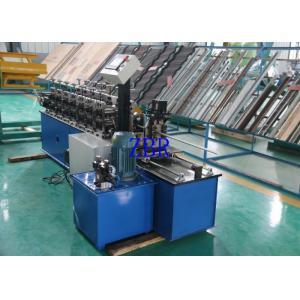

Add to Cart
Free Forging Door Frame Roll Forming Machine , Steel Door Frame Making Machines
Product Description
Ø MATERIAL:
(1) Coil Width: according to final test data
(2) Suitable Coil Thickness: 0.8~1.2mm
(3) Suitable Raw Materials: cold rolled steel plate (yield
strength: 235Mpa)
(4) suitable steel coil inner diameter: ¢508mm
(5) suitable steel coil outer diameter: ≤¢1300mm
(6) Suitable steel coil max weight: 3 Tons
Ø MAIN TECHNIQUE DATA OF LINE:
(1) Line working speed: 10~20m/min (according to different final
profile length)
(2) Each piece final products length tolerance: ±1.5mm
(3) Roll forming line power source: 380V/50HZ/3 Phase
(4) Air source requirement: >0.5Mpa
Ø ROLL FORMING LINE WORKING PROCESS:
Decoiler-leveler-material loop-feeder-puncher-material loop-roll
former-cuter-final products output
Ø MACHINE COMPONENTS:
(1) Hydraulic decoiler--1 set (decoiler capacity is 3 tons)
(2) Leveler mahcine-1 set
(3) Material loop-2 sets
(4) Servo feeding device-1 set
(5) Puncher-1 set
(6) Main roll former-- 1 set
(7) Hydraulic Cutter-- 1 set
(8) Hydraulic station-- 1set
(9) PLC control system - 1 set
(10) Final products rack-1set (total length is 4 meters)
LINE TECHNICAL SPECIFICATION OF EACH PART
(1) Hydraulic decoiler:
Automatic model; motor power drives decoiler shaft to opens steel
coil, and hydraulic power expands steel coil inner surface, in
order to make steel coil to be fixed well on decoiler shaft.
Decoiler also includes pneumatic power brake device.
The decoiler is single head model, max loading capacity: 3000kg
Max steel coil width: 400mm
Suitable steel coil inner-diameter: ¢508mm, max outer diameter:
¢1300mm
(2) Leveler machine:
Leveler machine is 7 rollers model. It includes 2 guider rollers
and 5 leveler rollers.
Leveler is driven by motor, and working speed can be adjusted.
Up layer leveler roller can be adjusted up and down, manual power
adjusts the rollers' space.
Suitable material thickness: 0.8~1.2mm
Max steel coil width: 400mm
(3) Material loop:
Complete line has two sets loop. One loop is between leveler and
puncher, and the last one is between puncher and main roll former.
Main aim of loops is to match different part working speed and make
complete line to be worked continuously.
Main components of loop are few photoelectric control switches.
(4) Servo feeding device:
Machine uses feeding shafts model, and this machine includes servo
motor, a pair of feeding shaft, transmission device, guider and
numerical control system. (Servo motor, measure accessories and
numerical control system are all used import products.)
Suitable material thickness: 0.8~1.2mm
Max feeding steel coil width: 400mm
When servo feeder matches with puncher, the max working speed is
20m/min.
Feeding roller material: 9Cr2Mo (or GCr15), heat treatment,
HRC55~60
Feeding length can be set freely, and operator can input 20 groups
feeding data at same time.
Servo motor power: about 3Kw
(5) Puncher:
The puncher is multi-station model; it is used to punch related
holes on the section surface.
The holes distance which is on horizontal direction (steel coil
width direction) can be adjusted accord to requirements. Whatever
the adjustment, change and repair is very convenient.
Punched includes 4working units and a complete set punch die.
Puncher is driven by hydraulic power, working speed is fast and
punch precision is high.
(6) Main roll former:
Main roll former uses single forming stand model, welded steel base
plate.
The max width of feeding guider: 300mm
Main roll former forming stand number: about 28
This roll former can produce two profiles at same machine, when
profile standard is changed, operator only needs to change and
adjust some forming rollers, and it will be ok.
The transmission system includes main motor, decelerator,
transmission shaft and gear box.
All down forming layer shafts are power shaft, up layer shafts have
not power.
Each forming stand up and down forming rollers' space can be
adjusted manually.
The roller is designed by professional software, and all rollers
dimension are precise;
Forming roller material: Cr12
(Heat treatment, HRC58~62, it is equal as American D2)
(Roller surface is polishing treatment.)
Forming shaft material: 40Cr (heat treatment, HRC45)
Forming shaft dimension: ¢60mm
Forming stand material: QT470
Main roll former working speed: 10~20m/min
Main motor power: about 18.5Kw
Machine base plate is welded steel model, all working actions are
control by electric cabinet.
(7) Flying Cutter:
The cutter model is flying cut; it is continuous cut style;
There is no waste piece after cut actions.
Cutter tool material: Cr12 (heat treatment, HRC58~62)
Cutter is driven by servo motor; cutter base plate is installed on
lead rail.
Cut length tolerance ±1.5mm
The cutter can be cutted the final products on confirmed length,
and the length is automatically fixed by coder.
(8) Hydraulic station:
It supplies the power for the hydraulic decoiler, puncher and
cutter.
Electromagnetic valve uses Italian "ATOS" brand products, and the
others hydraulic accessories use Chinese famous brand products.
Main components of hydraulic station are oil pump, motor, hydraulic
valve, pressure meter, filter, accumulator and etc.
Hydraulic oil standard: 46# hydraulic oil
Hydraulic oil cleanliness should keep grade 6~8.
Hydraulic motor power: about 4Kw
(9) PLC Control System:
This system uses Mitsubishi (or same level brand products) PLC to
control all working actions. Production quantity and each piece
length will be automatically measured; human and machine interface,
touch screen is input and cancelled the working data. It is
convenient to control the roll forming machine.
The control panel has English operation interface, it is convenient
to operator to input and cancel working date.
Main electrical accessories show:
PLC: MITSUBISHI (or same level products)
Inverter: Delta (China Taiwan products)
Coder: OMRON
(10) Product Rack (un-powered):
Two parts, each part length is 2 meters. The total length is 4
meters.
In order to collect the final product and final products is
convenient to be stacked by workers.
This rack can be disassembled easily, in order to satisfy different
working condition requirements.
Profile Drawing
